|
|
Post by Lee Martin on Feb 9, 2015 21:02:06 GMT -5
Redhawk single action grip----revolver in line with forearm. With a filling stock (Pachmayr presentation shown) middle finger becomes a load-bearing finger. Distal joint of trigger finger bears on trigger.  Thumb contacts middle finger. Since each shooter's anatomy is unique, proper hand position is a matter of individual adjustment. Not up for discussion: bore alignment to forearm and, smooth, straight-back squeeze. 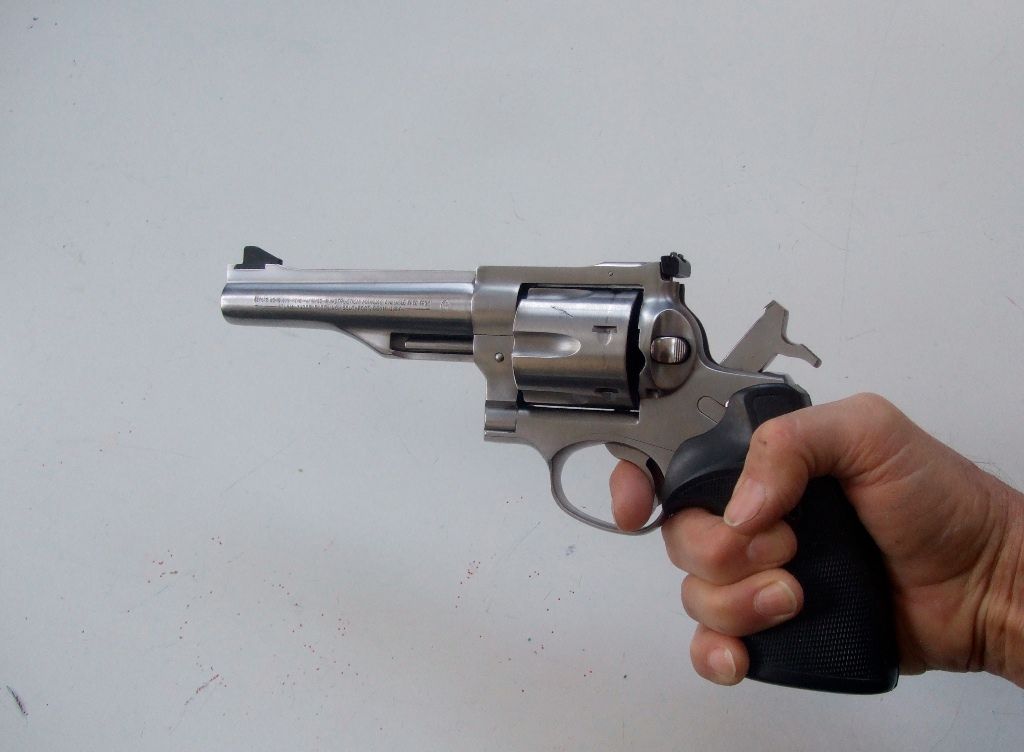 Despite distal joint on trigger, finger does not contact frame. 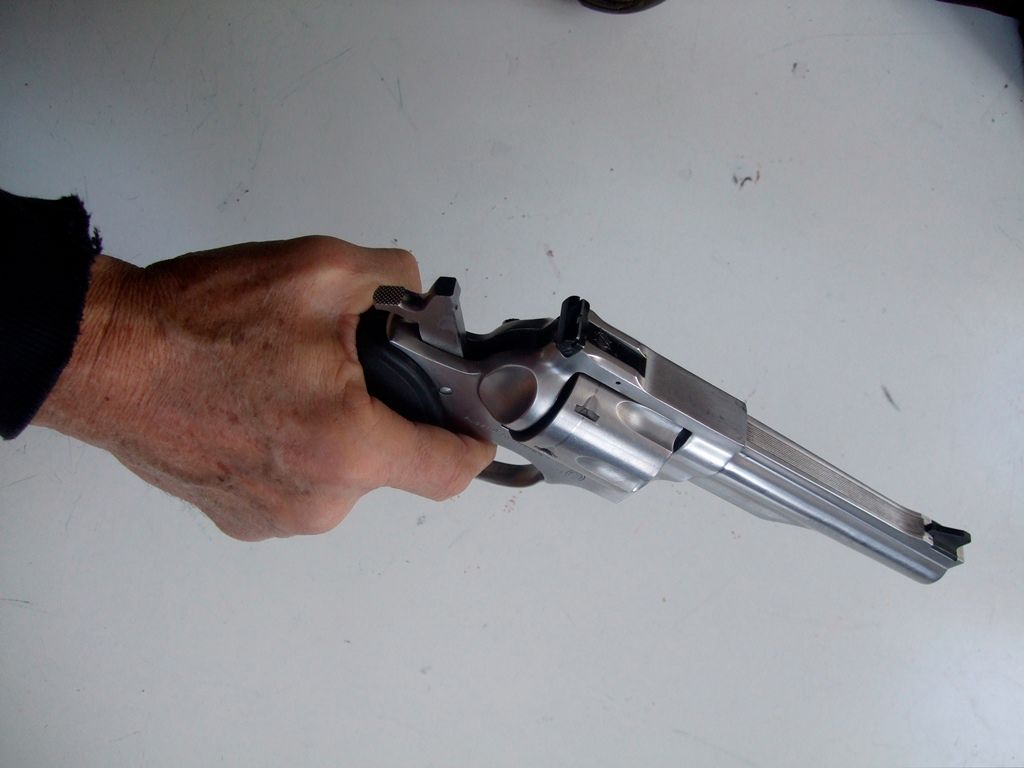 Relatively high spur of cocked Redhawk hammer lends itself to gloved shooting. Glove selection critical to control and trigger access. 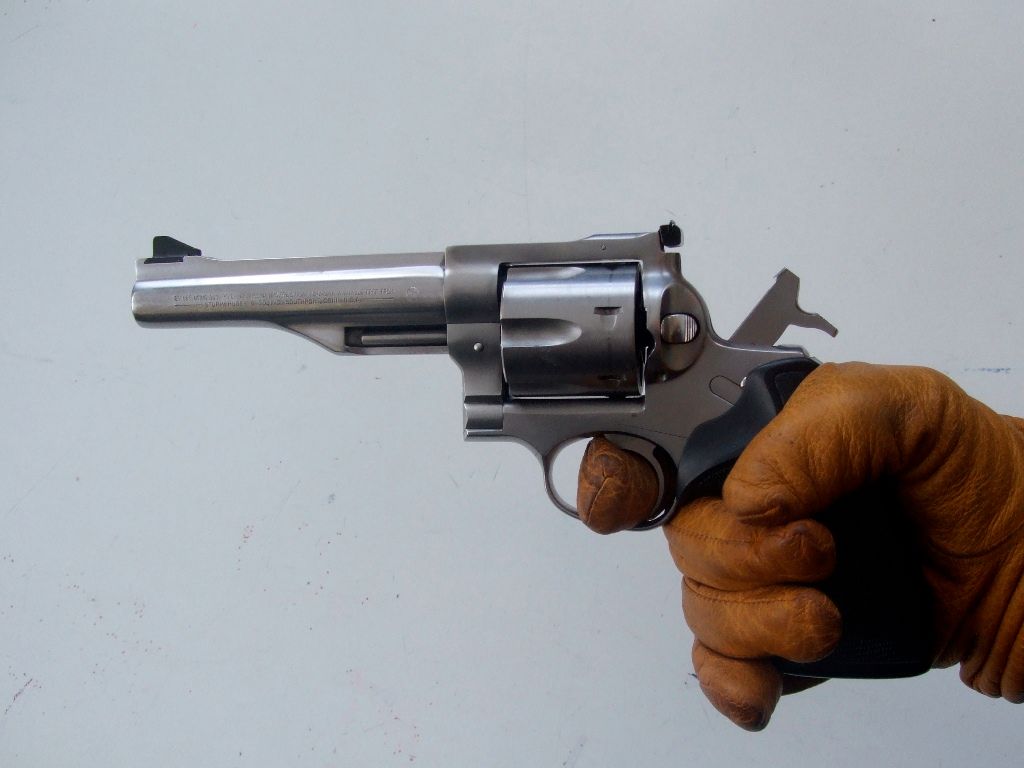 Redhawk double action grip----thumb contacts middle finger. (The individual shooter's hand determines whether thumb & finger touch. As always the target is the measure of trigger control.) Distal joint of index finger contacts trigger. Redhawk double action stroke is heavier than a tuned N-frame Smith, increasing effort required to rotate the Ruger's flywheel cylinder. 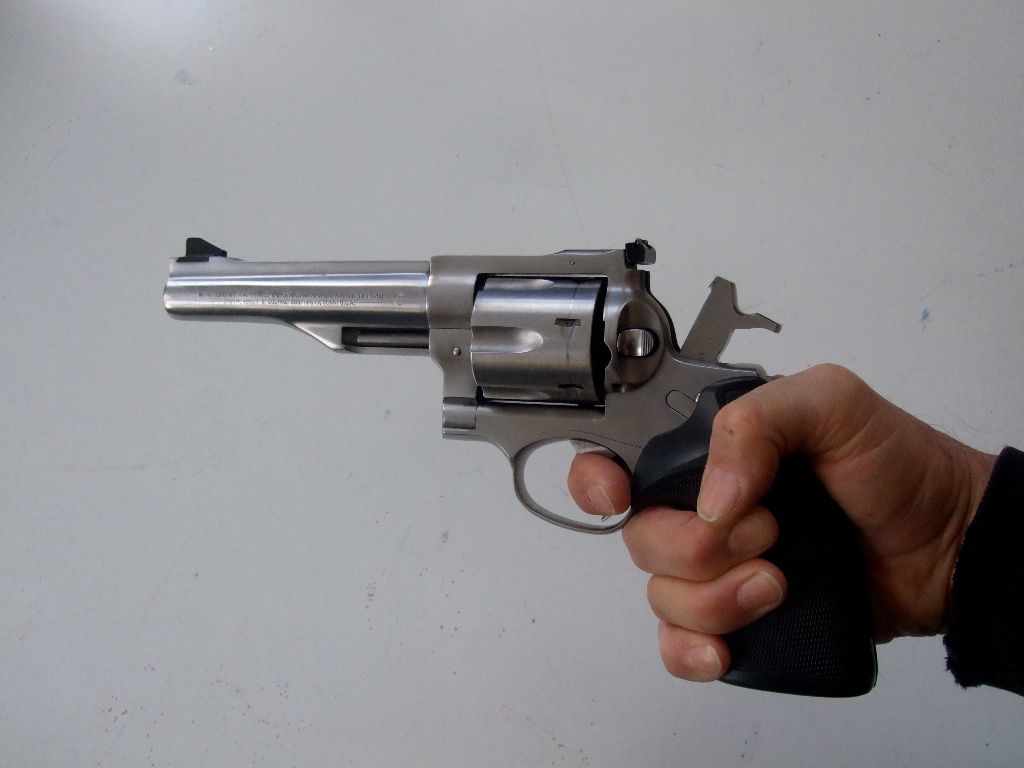 Top view shows trigger finger in DA stroke. 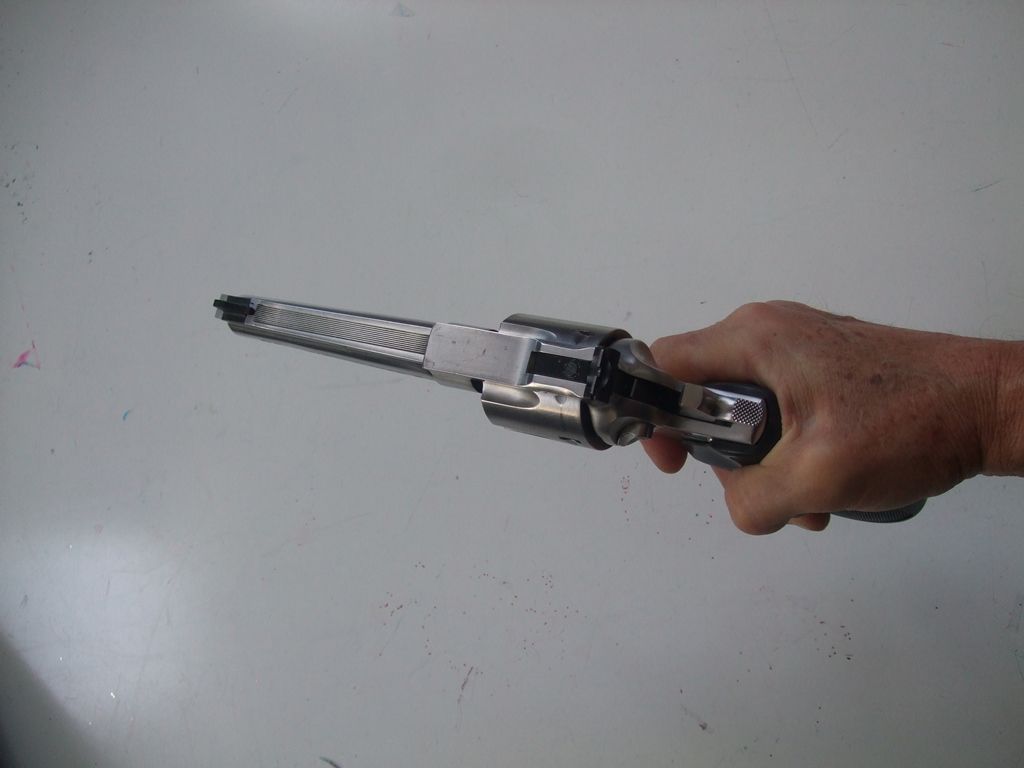 Redhawk gloved DA grip----rarely if ever should double action be necessary when afield. Big hairy animals make the exception. Normal trail work begins from the leather, providing time to cock as revolver rises to line or sight. Emergencies are not so smooth. To shoot DA with a gloved hand mandates practice. The gloved finger must enter the trigger guard without waiting for an act of congress.  Not only must gloved finger enter trigger guard smoothly to fire double action, glove must allow for trigger reset. Just as accuracy depends on a straight-back squeeze, reset requires a straight-forward release. Fingernail presses against trigger guard; reset is felt. A double action trigger that doesn't reset cannot be squeezed. 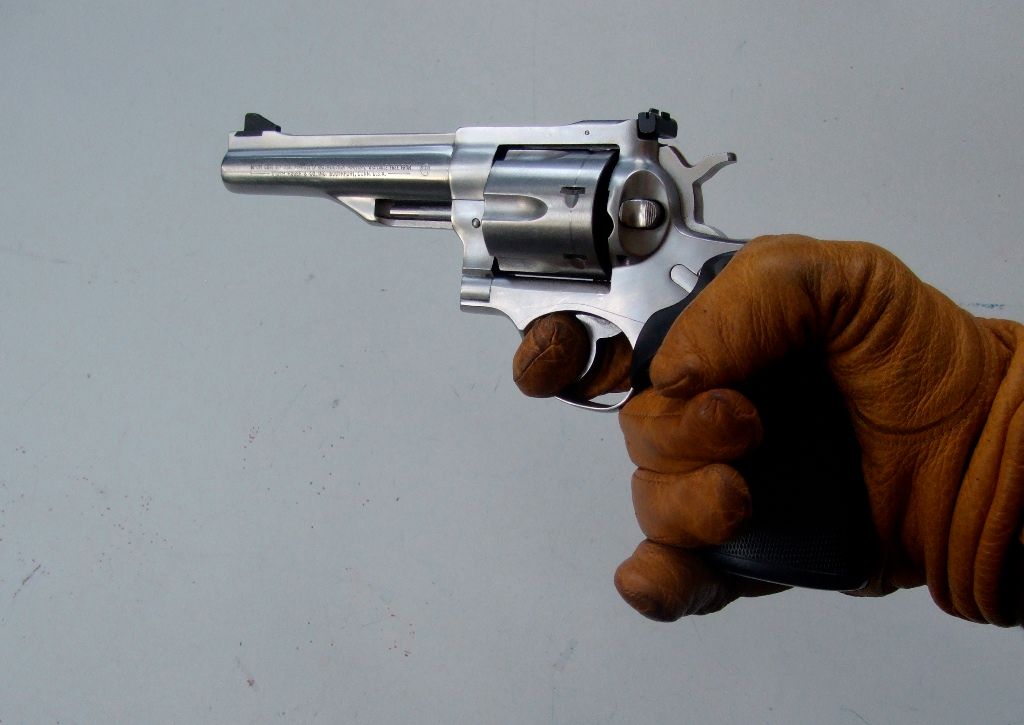 -Lee www.singleactions.com"Building carpal tunnel one round at a time" |
|
|
|
Post by bradshaw on Feb 10, 2015 10:30:43 GMT -5
The Pachmayr Presentation stock for the Redhawk is, like the revolver itself, somewhat overbuilt. Bill Ruger used the Model 29 as a model both for what he wanted and did NOT want in a double action .44 Magnum. He wanted smoothness and utility. He did not want borderline strength----any propensity for parts to loosen or fail under a continuous diet of 40,000 CUP loads. Lost wax casting provided Ruger the essential manufacturing technique by which to make a "solid frame" double action, thereby departing from the "sideplate frame" standard to drop forging----as seen on S&W and Colt DA's. Aside from adopting the counter-clockwise carry-up of S&W, the Redhawk grip frame is a virtual tracing of the N-frame. about the only difference, the Redhawk hump rises higher up the backstrap.
Perhaps as a tip of the hat to tradition, Ruger pushed aside the "grip spike" concept set forth by Warren Center and Dan Wesson, to settle on the iron handle frame of Smith & Wesson.
The magna-style wood grips which come on the Redhawk feel good to this shooter----when confined to the original 7-1/2" barrel. When I received the new 5-1/2" Redhawk in 1982, I immediately cleaned and lubricated the works, and proceeded to try it with .44 Specials. Felt great. After a 50 round box of Specials, the cylinder was charged with Federal 44B 180 JHP. Ouch! Recoil whacked the base of my thumb. Fed 44B produces 1610 fps from the 5-1/2" Redhawk----exactly the figure given in Federal data----and the recoil is sharp. (And, contrary to what may say about light bullets in the .44, Federal's 180 JHP is genuine deer killing medicine.)
Single Action: photos 1-4
Cut lines for first photos state "distal joint of trigger finger bears on trigger." True of my grip and squeeze in single action.
Double Action: photos 5-8
Pad of finger----next to distal joint----bears on trigger. Squeeze straight back into forearm.
David Bradshaw
|
|
|
|
Post by Markbo on Feb 10, 2015 13:30:47 GMT -5
It sure looks like its touching the frame to me  |
|
|
|
Post by bradshaw on Feb 10, 2015 21:59:56 GMT -5
Markbo.... and you're right. Revolver in hand as we speak. .. putting down to write. Touch contact, yes. Pressure contact, no.
David Bradshaw
|
|
|
|
Post by bigmuddy on Feb 10, 2015 23:42:05 GMT -5
David
Great post.... And thank you again for all you bring to us. It IS appreciated.
First time I have ever seen anyone else say to contact the trigger with the distal joint for SA shooting. I found years ago to do that very thing when shooting Big Red. I have had more than one fellow shooter question me when I tell them that but it is what I found to work with that gun. Most have just told me they hate the Ruger trigger.
I normally don't get along with finger grooved grips but the Uncle Mike's fit my hand just right. I too think the Pachs are too big. Really like the factory grip as long as the loads are mild. Was out today shooting my Redhawk 45 with 270 gr. bullets at 1050fps. The factory grip works very well with that load. (mine is elk antler but the same profile as factory)
Thanks again!
Dan
|
|
|
|
Post by bradshaw on Feb 13, 2015 8:45:11 GMT -5
Dan.... there is a mountain of bad literature on technique. You learned by trial and error how to put your bullets on target. Doctrine must emphasize a few basics: balanced stance, breathing to control nerves and eyes, accumulation of pressure on trigger. Beyond the foundation, technique develops within----not without----individual anatomy. Anatomy with experience evolves how the individual holds a handgun.
Keep shooting,
David Bradshaw
|
|
|
|
Post by bradshaw on Jun 11, 2019 7:38:42 GMT -5
45MAN.... reviving DB Vol. 54 (Latin: L=50 + IV=4), in conjunction with your search to get a grip on your Redhawk.
The Redhawk grip frame follows the lines of the S&W N-frame, with the hump higher on the Redhawk. The Redhawk represents Bill Ruger’s challenge to Smith & Wesson’s N-frame Model 29 as the premier big bore double action. From a strength standpoint, four major advances distinguish the Redhawk:
1) Massive frame.
2) “Solid” frame----elimination of sideplate.
3) Forward locking crane.
4) Offset ejector rod----increase diameter of barrel socket in frame, provides thicker barrel tenon.
The Redhawk does not abandon tradition altogether, retaining the traditional DA grip with frontstrap & backstop. And retention of a ribbed barrel. The traditional DA grip frame increases production cost over the grip-spike design used by Warren Center and Dan Wesson, as does a ribbed barrel, machined from a drop forging. Ruger shortly reduced production cost with the Super Redhawk, with grip-spike and a barrel hammer forged from round stock.
Introduced during a period of intense magnum revolver shooting, the Redhawk quickly silenced doubts of double action durability, at the same time showing the gun to be much tougher than the hands firing it. Introduction of 5-1/2” barrel accentuated the need for a recoil-absorbing grip, as the base of thump takes a heavy smack from the short barrel. Yes, the Redhawk happily runs in a higher rpm range than the N-frame Smith, and does so continuously. No double action has come along to challenge overall durability of the Redhawk and its sister Super Redhawk, neither big frame Dan Wesson, nor X-frame S&W. (Notwithstanding the X-frame carries mass to beastly proportions, it remains a sideplate revolver----without the Ruger crane latch.)
I gave Ruger drawings for a Redhawk with rounded backstrap, ala Ruger Bisley, which earned a yawn. Understandable, as the Super Redhawk solves a couple of deficiencies (grip-spike and separate trigger rebound spring). Meanwhile, back in the jungle we continue with our Redhawks. I love the Model 29, it represents an entire college in my education. Yet there are times I strap on the 5-1/2 inch Redhawk, for all that it is, and it has never let me down. Most often dressed in one or another Pachmayr Presentation----the stock version, or a Presentation carefully beaver-chewed to narrow the toe area.
David Bradshaw
|
|
|
|
Post by contender on Jun 13, 2019 9:40:42 GMT -5
Once again, excellent info & explanations. And yes,, while most schools teach the use of the middle of the pad of the first joint as the correct placement,, read the critical info posted. Personal anatomy is the key here. Many people have different hand sizes & shapes & "one size (or method) fists all is NOT always the answer. Jerry Miculek & I discussed some of this once & he too uses the digital joint for some of his shooting. Hard to argue with a Master.
|
|
|
|
Post by bradshaw on Feb 13, 2024 0:11:48 GMT -5
wyomingnimrod.... double action shooting is its own discipline. Fastest way to proficiency requires frequent DRY FIRE sessions, over a long period of time. To read the sights while squeezing the trigger self-critiques control. Forget trying to stage the trigger, especially Ruger’s double action. The Redhawk has a flywheel for a cylinder: spins easy, but first it must be set in motion, then stopped. Double action shooting is like driving a manual transmission with your trigger finger. A proper S&W K frame feels silky and light to the trained finger; aside from the fabled S&W lockwork, it has a featherweight cylinder. CARRY-UP----the sequence of cocking, cylinder unlocking, cylinder rotation, cylinder lockup, and hammer fall----feels different from maker to another, and between model s of the same make, and between examples of the same model.
Doubt 1 out of 10,000 owners sets out to master the Redahwk double action. I’m one of the ten thousand. I would not try to better with a Redhawk my DA shooting with the Model 29. Some decades in the past I entered a combat match in Texas with my 5-1/2” Redhawk & Pachmayr Presentation grips. Hitting all the man silhouettes, one shot each, clouds of caliche exploding off the berms behind. My load for this little match hardly skimped on the Power Factor: Federal 44B .44 Mag, 180 JHP, averaging 1,610 fps fro the 5-1/2” barrel. My entry was disqualified.
“You have to shoot each target twice,” admonished the Big Poobah.
“Oh, do you really think so?”
Providing you are committed to learning big bore double action, go for it. Start DA practice with even pressure from commensing squeeze through hammer fall. Your finger draws a line from the trigger to your eye. Hold sight picture throughout, chisel the front sight. Release trigger in the same slow motion you squeeze it. The SQUEEZE & RELEASE tones the tendons & muscles of your finger and conditions your mind to accurac. the accuracy develops under stress and from which speed grows. Double action technique develops in dry fire and from live fire using light loads. Speed follows accuracy. Magnum control conditions from accuracy with light light loads.
If there is a short cut it is called determination, which is the commitment to practice. My advice to those who have drowned: if you’re going to go fishing, learn to swim.
There are two sides to a double action revolver. double & single action. In the big bore category, single action reigns supreme. My aim is to take advantage of both.
David Bradshaw
|
|
|
|
Post by wyomingnimrod on Feb 14, 2024 18:29:32 GMT -5
Thank you for the knowledge and taking the time to share it in detail, David. It is a privilege to have access to your experience and that of many others here, offered so freely and generously. I am sure I am not the only one who appreciates it and I’ll do my best to put it to good use on my quest to be more proficient with my weapons. All the best and Happy Valentines Day to all.
Phil
|
|




















